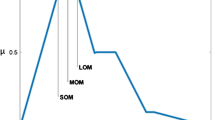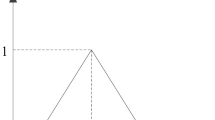Abstract
Most contact center employees experience work related injuries, leading to decreased productivity and performance. The increased risk is due to poor workstation design, such as indecent noise level and duration exposure experienced by call center agents daily, while receiving and making calls on a headset or telephone. Some illnesses caused by prolonged exposure to unfavorable acoustics are headaches, increased anxiety levels, tinnitus, and noise-induced hearing loss. Mathematical modelling has only been applied in optimizing systems considering musculoskeletal disorders and only in other industries. Thus, it is important to consider the auditory ergonomic risks faced by call center agents mathematically. This study proposes Fuzzy Data Envelopment Risk Analysis (FDERA), a DEA-based risk analysis tool that considers the presence of imprecise data. The validity of the model is demonstrated using a case example. The results of the proposed tool are relative risk efficiency scores for each agent. Guidelines for interventions to improve risk efficiencies are presented using a matrix that provides possible preventive and corrective measures to address risks.
Access this chapter
Tax calculation will be finalised at checkout
Purchases are for personal use only
Similar content being viewed by others
References
Errighi, Khatiwada, Bodwell (2016) Business process outsourcing in the Philippines: Challenges for decent work. ILO Asia- Pacific Working Paper Series
Norman: Call centre work – characteristics, physical, and psychosocial exposure, and health related outcomes (2005)
OSHA (2000) Ergonomics: The Study of Work. https://www.osha.gov/Publications/osha3125.pdf
Lan L, Wargocki P, Lian Z (2011) Quantitative measurement of productivity loss due to thermal discomfort. Energy Build 43(5):1057–1062
Kurakata K, Mizunami T, Matsushita K (2007) Accessible design in auditory ergonomics, p 1–7
Tiesler G, Oberdoerster M (2008) Noise - a stress factor? acoustic ergonomics at schools. J Acoustical Soc Am 123(5):3918
Beyan A, Demiral Y, Cimrin A, Ergor A (2016) Call centers and noise-induced hearing loss. Noise Health 18(81):113
Choi G (2009) A goal programming mixed-model line balancing for processing time and physical workload. Comput Ind Eng 57(1):395–400
Xu Z (2010) Design of Assembly Lines with the Concurrent Consideration of Productivity and Upper Extremity Musculoskeletal Disorders using Linear Models (Master’s thesis)
Mummolo G, Mossa G, Boenzi F, Digiesi S (2015) Productivity and ergonomic risk in human based production systems: a job-rotation scheduling model. Int J Prod Econ 171:471–477
Chang S, Chen T (2006) Discriminating relative workload level by data envelopment analysis. Int J Ind Ergon 36(9):773–778
Azadeh A, Motevali Haghighi S, Gaeini Z, Shabanpour N (2016) Optimization of healthcare supply chain in context of macro-ergonomics factors by a unique mathematical programming approach. Appl. Ergon 55:46–55
Ramanathan R (2001) Comparative risk assessment of energy supply technologies: a data envelopment analysis approach. Energy 26(2):197–203
Rougier J, Rougier J, Hill LJ, Sparks RS (2013) Risk and uncertainty assessment for natural hazards. Cambridge University Press, New York
Azadeh A, Alem S (2010) A flexible deterministic, stochastic and fuzzy Data Envelopment Analysis approach for supply chain risk and vendor selection problem: Simulation analysis. Expert Syst Appl 37(12):7438–7448
Project Management Institute Inc.: A guide to the project management body of knowledge (PMBOK® guide) (2000)
Chapman C, Ward S (2004) Why risk efficiency is a key aspect of best practice projects. Int J Project Manag 22(8):619–632
Yang H, Pollitt M (2009) Incorporating both undesirable outputs and uncontrollable variables into DEA: the performance of Chinese coal-fired power plants. Eur J Oper Res 197(3):1095–1105
Puri J, Yadav SP (2014) A fuzzy DEA model with undesirable fuzzy outputs and its application to the banking sector in India. Expert Syst Appl 41(14):6419–6432
Golmohammadi R, Eshaghi M, Khoram MR (2011) Fuzzy Logic Method for Assessment of Noise Exposure Risk in an Industrial Workplace 3(2):49–55
Pawlaczyk-Łuszczyńska M, Dudarewicz A, Zamojska-Daniszewska M, Rutkowska-Kaczmarek P, Zaborowski K (2017) Noise exposure and hearing threshold levels in call center operators. ICBEN
DisMark Tinnitus (2017) Tinnitus hearing-test - Sound therapy helps against tinnitus, ringing in the ears. http://www.tinnitool.com/en/tinnitus_analyse/hoertest.php. Accessed 2017/12/11
Author information
Authors and Affiliations
Corresponding author
Editor information
Editors and Affiliations
Appendix
Appendix
Appendix A. Translated Triangular Fuzzy Numbers
Low/Mid/High | |||||
|---|---|---|---|---|---|
DMU | Noise Level | Noise Duration | Anxiety Level | Tinnitus | Performance |
1 | 65/70/75 | 2/4/6 | 0.55/1.625/3 | 0.03 | 0.85/0.9/0.95 |
2 | 90/95/100 | 1/2/3 | 0.1/0.42/0.9 | 0.53 | 0.72/0.79/0.85 |
3 | 65/70/75 | 1/2/3 | 1.2/2.5/4.2 | 0.01 | 0.9/0.95/1 |
4 | 80/85/90 | 2/4/6 | 0.86/2.325/4 | 0.25 | 0.72/0.79/0.85 |
5 | 72/78.5/85 | 5/6.5/8 | 1.65/3.25/5.25 | 0.05 | 0.8/0.85/0.9 |
6 | 65/70/75 | 2/4/6 | 0.7/1.2/1.8 | 0.01 | 0.86/0.9/0.95 |
7 | 90/95/100 | 2/4/6 | 4.2/6.4/9 | 0.64 | 0.1/0.43/0.75 |
8 | 85/90/95 | 1/2/3 | 1.65/3.25/5.25 | 0.08 | 0.8/0.85/0.9 |
9 | 65/70/75 | 5/6.5/8 | 0.1/0.42/0.9 | 0.03 | 0.9/0.95/1 |
10 | 80/85/90 | 5/6.5/8 | 5.167.44/10 | 0.15 | 0.72/0.79/0.85 |
Rights and permissions
Copyright information
© 2019 Springer Nature Switzerland AG
About this paper
Cite this paper
Go, E.M., Ong, K.B., Juan, J.L.S., Sia, W.G., Tiu, R.H., Li, R. (2019). Development of Fuzzy Data Envelopment Risk Analysis Applied on Auditory Ergonomics for Call Center Agents in the Philippines. In: Bagnara, S., Tartaglia, R., Albolino, S., Alexander, T., Fujita, Y. (eds) Proceedings of the 20th Congress of the International Ergonomics Association (IEA 2018). IEA 2018. Advances in Intelligent Systems and Computing, vol 827. Springer, Cham. https://doi.org/10.1007/978-3-319-96059-3_2
Download citation
DOI: https://doi.org/10.1007/978-3-319-96059-3_2
Published:
Publisher Name: Springer, Cham
Print ISBN: 978-3-319-96058-6
Online ISBN: 978-3-319-96059-3
eBook Packages: Intelligent Technologies and RoboticsIntelligent Technologies and Robotics (R0)




